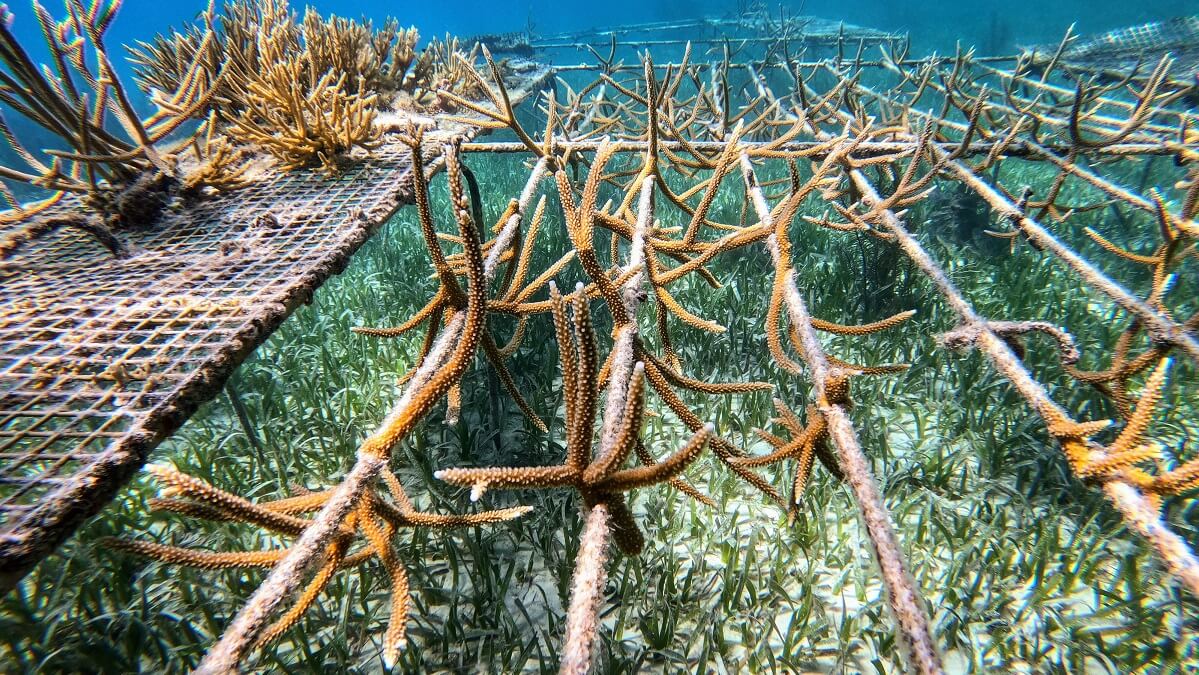Corals grown in Australia’s first offshore coral nursery at Fitzroy Island off Cairns are ready to spawn for the first time since being planted on the Great Barrier Reef four years ago, but are keeping their proud parents waiting for the big reveal.
The team at the not-for-profit Reef Restoration Foundation had hoped to see thousands of tiny pink bundles of eggs and sperm erupting from branching acropora corals planted in Welcome Bay last week.
However, marine biologist Azri Saparwan, the master reef guide who helped to plant the corals in 2018, said the inshore hard corals, including nearby hard corals that had grown naturally on the reef, were holding onto their bundles of sperm and eggs.
“We did see spawn coming from the soft corals which is usually a precursor to the hard corals spawning,” he said.
“In the past few years, Fitzroy Island has always spawned in October, but the full moon was a bit earlier this year so the inshore reefs may not spawn until the full moon in November.
“The conditions have been good for spawning with calm 28°C water and a big slack tide so there isn’t much movement on the surface, but we have had cloudier conditions and some rain in October which is unusual and may have delayed the spawning.”
Read: Splash out on a trip to the Great Barrier Reef
Reef Restoration Foundation chief executive officer Ryan Donnelly said his team of marine biologists and a coral farming expert would be back again after the November full moon to see if the hard corals spawn.
“We broke open fragments of the corals that we had planted and discovered that they were ready to spawn, but other variables have not lined up for spawning,” he said.
The inshore reefs off Cairns tend to spawn a month ahead of the outer Great Barrier Reef where the sheer volume of corals reproducing creates big slicks of spawn on the water.
The planted corals at Fitzroy Island were grown on underwater frames after the Great Barrier Reef Marine Park Authority granted a permit for a pilot research offshore nursery at Fitzroy Island in 2017.
“We planted coral cuttings in a degraded patch of reef and these pioneer species have grown to around one metre in diameter, helping to create a healthy and complex habitat for various corals and marine life,” Mr Saparwan said.
Read: Is it too late to see the reef?
Cameron Bee who has 25 years’ experience in coral aquaculture, creating coral farms around the Asia-Pacific region and is part of the Great Barrier Reef Legacy’s Living Coral Biobank project to preserve coral diversity, was part of the team hoping to record the coral spawning.
“We are facilitating reef recovery in a time when disturbances are more frequent and severe. Growing corals to create habitat is important but additionally taking them through to spawning is a milestone in our bid to maintain biodiversity,” he said.
Mr Donnelly said Reef Restoration Foundation partnered with the Tropical North Queensland tourism industry and corporate sponsors to create the Fitzroy Island nursery and expand to two outer reef sites on Hastings and Moore Reefs.
“It is a community effort as we receive no government funding and rely on the support of around 50 volunteers, with about one-third of these experienced divers working in the tourism industry,” he said.
“Cuttings at this site were taken from healthy corals and attached to ‘coral tree’ frames suspended underwater using techniques pioneered at reef restoration sites in Florida.
“These cuttings grow faster in the nursery setting allowing us to then plant them onto hard substrate after about six months.
“As these cuttings establish themselves, other coral species also become established and marine life including invertebrates, colourful tropical fish and turtles become part of the habitat.
“Coral spawning is our second goal after achieving a complex habitat as it means the reef is regenerating as nature intended.
Read: Four-year coral nurture program ‘unprecedented success’
“Successful coral spawning will mark a critical threshold for Reef Restoration Foundation, which was a start-up organisation building partnerships and supporters from nothing five short years ago.
“The challenge for the Great Barrier Reef is far from over with scientists telling us the water will continue to warm, but we are up for the fight. In a changing climate, it is all about buying time and selling hope,” said Mr Donnelly.
“We need to drastically reduce global emissions, but at the same time work collaboratively to build the resilience of the places we love. We all have a role to play.”
Have you visited Great Barrier Reef? What did you think of the health of the coral? Let us know in the comments section below.

